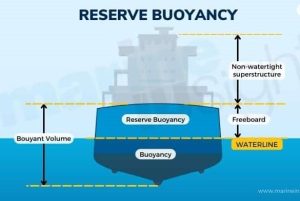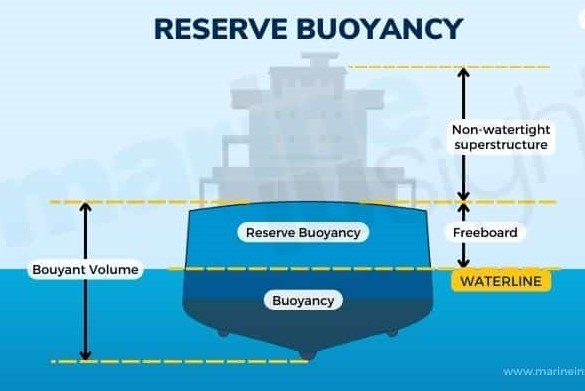What is Buoyancy?
Buoyancy is a fundamental concept that allows ships to float and navigate the vast oceans. Despite their massive size and weight, ships remain afloat due to the principles of buoyancy, which are rooted in the laws of physics. This article delves into the science of buoyancy, exploring how it works and why it is crucial for marine vessels. Buoyancy is the upward force exerted by a fluid (liquid or gas) that opposes the weight of an object immersed in it. This phenomenon was first described by the ancient Greek scientist Archimedes, who formulated the principle now known as Archimedes’ Principle. According to this principle, the buoyant force on an object is equal to the weight of the fluid displaced by the object.
Archimedes’ Principle : Archimedes’ Principle states: “An object wholly or partially immersed in a fluid is buoyed up by a force equal to the weight of the fluid displaced by the object.” This principle explains why objects float or sink depending on their density relative to the fluid they are in. For a ship, the key to floating is displacing a volume of water whose weight is equal to or greater than the weight of the ship. The design of the ship, particularly its hull, plays a vital role in achieving this balance.
The Role of Density : Density is the mass per unit volume of a substance. In the context of buoyancy, it is crucial to compare the density of the ship to the density of the water. Water has a density of approximately 1,000 kg/m³. If a ship is less dense than the water, it will float; if it is denser, it will sink. A ship is typically made of materials that are denser than water, such as steel. However, its overall density is reduced by incorporating large volumes of air within its structure. The shape of the hull, which is designed to displace a significant amount of water, ensures that the ship’s average density remains lower than that of water.
The Hull Design : The hull of a ship is the watertight body that extends below the waterline. The hull’s design is crucial for buoyancy and stability. It is typically wide and shaped to displace a large volume of water. The larger the volume of water displaced, the greater the buoyant force. There are several factors considered in hull design:
- Volume Displacement: Ensuring that the ship displaces enough water to support its weight.
- Stability: Designing the hull to maintain balance and resist capsizing.
- Hydrodynamics: Shaping the hull to reduce resistance and improve movement through the water.
Calculating Buoyancy
To determine whether a ship will float, engineers calculate the buoyant force and compare it to the ship’s weight. The buoyant force (B) can be calculated using the formula: B=ρ×V×g
where:
- ρ is the density of the fluid (water),
- V is the volume of water displaced by the ship,
- g is the acceleration due to gravity (approximately 9.8 m/s²).
For a ship to float, the buoyant force must be equal to or greater than the gravitational force acting on the ship (its weight).

Credit: Marineinsight.
Importance of Stability in Marine Vessels
Stability is paramount for a ship’s safety and operational efficiency. A stable ship resists capsizing and can recover from tilting caused by waves, wind, or uneven loading. The concepts of the center of buoyancy and the center of gravity are central to understanding ship stability.
Center of Buoyancy and Center of Gravity
The center of buoyancy is the point where the upward buoyant force, which keeps the ship afloat, acts. It is the centroid of the displaced volume of water. The center of gravity, on the other hand, is the point where the weight of the ship is concentrated. For a ship to be stable, these two points must be in a proper relationship:
- Vertical Alignment: Ideally, the center of gravity should be below the center of buoyancy. This configuration ensures that if the ship tilts, the buoyant force will create a righting moment to bring the ship back to an upright position.
- Righting Moment: When a ship tilts, the shape of the submerged hull changes, causing the center of buoyancy to shift horizontally. This shift generates a righting moment, which is the force that acts to return the ship to its upright position. The magnitude of this righting moment depends on the distance between the center of buoyancy and the center of gravity.
- Metacentric Height (GM): The metacentric height is a critical measure of stability. It is the distance between the center of gravity (G) and the metacenter (M), a point where the line of action of buoyancy intersects the centerline when the ship is heeled. A larger GM indicates greater stability.
Stability During Tilting
When a ship tilts due to external forces, the following occurs:
- Shift in Center of Buoyancy: The center of buoyancy moves towards the side that is submerged more deeply.
- Righting Moment: The horizontal distance between the center of buoyancy and the center of gravity creates a lever arm. This lever arm generates a moment that tries to right the ship.
- Restoration: If the righting moment is sufficient, it will counteract the tilting force and restore the ship to its upright position.
However, if the center of gravity is too high or if the tilt angle is too extreme, the righting moment may not be sufficient to prevent capsizing.
Designing Ships for Damage Stability
In addition to stability under normal conditions, ships must be designed to remain afloat and stable even in the event of damage, accidents, or flooding. This aspect of ship design is governed by regulations such as the Safety of Life at Sea (SOLAS) Convention.
SOLAS Regulations and Damage Stability
SOLAS sets international standards for the construction, equipment, and operation of ships to ensure safety. Key provisions related to damage stability include:
- Watertight Compartments: Ships are divided into multiple watertight compartments by bulkheads. If one compartment is breached, the watertight bulkheads prevent water from flooding other compartments, limiting the extent of flooding.
- Subdivision and Damage Stability Calculations: Ships must undergo damage stability calculations to ensure they can survive specific damage scenarios. These calculations consider the worst-case flooding of one or more compartments and assess the ship’s ability to remain afloat and upright.
- Double Hulls: Many modern ships, especially tankers, are designed with double hulls. This design provides an extra layer of protection against breaches and reduces the risk of pollution in the event of an accident.
- Automatic Closing Devices: SOLAS requires the installation of automatic watertight doors and remote-controlled valves to quickly isolate damaged compartments.
- Bilge Pumps and Emergency Systems: Ships are equipped with bilge pumps and emergency systems to remove water and maintain buoyancy in case of flooding. These systems must be capable of handling the expected rate of water ingress.
- Stability Booklet: Each ship must have a stability booklet, which provides detailed information on the ship’s stability characteristics, including instructions for maintaining stability under various loading conditions and emergency situations.
Practical Applications
Understanding buoyancy is essential for designing various marine vessels, from small boats to massive cargo ships. Engineers apply the principles of buoyancy to ensure that these vessels can carry heavy loads, remain stable in rough seas, and navigate efficiently.
Buoyancy is a critical concept that enables ships to float and function safely in water. By understanding and applying the principles of buoyancy, shipbuilders can design vessels that are both efficient and safe. Whether for commercial, military, or recreational purposes, the science of buoyancy remains at the heart of marine engineering, ensuring that ships of all sizes can conquer the oceans.


My spouse and I stumbled over here different page and thought I should check things out.
I like what I see so i am just following you. Look forward
to finding out about your web page for a second time.